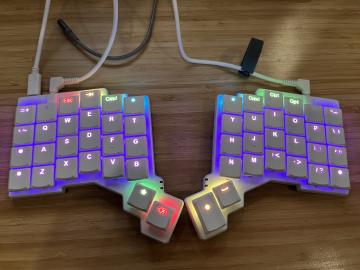I got a new keyboard.

It has been four years since I could no longer go work from a cafe, and I miss it very much. I can type for long stretches now using an ErgoDox-EZ, which I loved so much that I built a website to visually explain to others how it helped me: https://keymap.click. However, it’s large and bulky, making it unweildy to pack up and move around. Last month, ZSA released the Voyager, a board that works like the ErgoDox, but it’s smaller, lighter, and designed for travel… at the expense of some keys.
Will I be able to use it instead of an ErgoDox for typing at the cafe? The hurdles I’m expecting are:
-
The keys that are removed on the Voyager compared to the ErgoDox include many keys I need to avoid pain. I’m not sure if I can type pain free without them.
-
I use the ErgoDox with its tenting legs, meaning that the two halves of the board are higher at my thumbs than they are at my pinkies, which keeps my hands at a more natural angle than if the board were flat. The Voyager does have the ability to tent via magnetically attached legs, but the angle is much lower. I’m not sure if this will be painful or not.
-
Cafe tables are usually at a bad height for a keyboard, because optimal height for food and drink is higher than the optimal height for typing, where your elbows should bend at 90 degrees. This isn’t something the Voyager can help with of course, but it is my use case for the keyboard.
Keyboard layout
I’ve spent most of my time so far building a keyboard layout to address the first issue. Here’s what I’ve been working on:
Getting something that works for my wrists has been a challenge, but this result is pretty good for my use. I need very much to keep from chording with the pinky – repeated movements like shift or ctrl plus any key on the same hand have come to be very painful. I also need to keep the most common keys like space, return, backspace, tab, and esc off of the pinky. (Isn’t it unfortunate that all chords and most common single keys required the pinky, the weakest finger on your hands?)
This layout has done that, but at the significant cost of moving the numbers to a layer. Instead of the row above QWERTY being numbers, it’s many of these chords and common single keys. It’s been hard to learn because of how ingrained the number keys are to my muscle memory, but – and things could change as I’m still practicing this layout – the result seems to work pretty well. A few things to call out:
- The number layer also includes the punctuation from shift + number keys:
!@#$%^&*(). This means I never need to hold down the number layer key plus shift. - The number layer also contains arrow keys, home/pgdn/pgup/end, and forward delete.
- I have a layer for mouse keys and a layer for F1-F20, although I only use them rarely.
- I can’t seem to get used to keys which have different functions for tap vs hold, so I don’t use them. These would be nice, allowing thumb keys to do double duty where e.g. a tap is backspace but a hold is shift, but the tradeoff is the key gets recogtnized only after a delay (so the firmware can determine if it was tapped or held), and that delay throws me off every time.
So far, I still miss the full key set of the ErgoDox layout. Chorded keyboard shortcuts with combinations of cmd, ctrl, and/or opt are much more fluid when I have all of them available under my thumb rather than index and middle fingers, and relegating the numbers to a different layer really is hard to get used to.
Still, it seems to work. For example, I’ve used it to type this whole post and write Go and CSS.
Tenting
The tenting is OK, but long stretches with the Voyager tenting hurt my hand while long stretches with the ErgoDox do not.
Fortunately, I have two options to explore: custom tenting legs, and the tripod mount.
The tenting legs are magnetically attached, and specifically designed to allow users to harvest the magnets for other projects. I hope that someone makes legs that will tent at a steeper angle, but I haven’t spent much time looking yet.
I did buy the Tripod Mount Kit with the Voyager. This consists of two standard tripod mounts which attach to the back of each half with strong magnets. The magnet strength is significant – they’re very hard to remove if you don’t actually have a tripod attached to them for leverage. With the right accessories, these can tilt the boards at any possible angle, including much more extreme angles than the ErgoDox is capable of.
I’ll explore both of these more with time.
The cafe
I’ve even taken it to a cafe for about 90 minutes.
I’m really glad I did. The result wasn’t perfect, and the table height and low tent angle were problems, as I suspected. I probably couldn’t type there all day.
But damn. To be about in public on my laptop again. I have really missed that.

